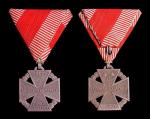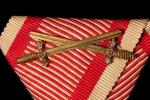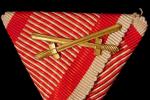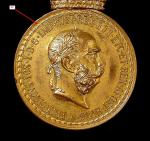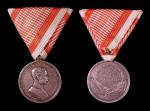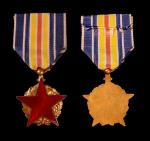
Tim B
Past Contributor-
Posts
2,234 -
Joined
-
Last visited
-
Days Won
2
Content Type
Profiles
Forums
Blogs
Gallery
Events
Store
Everything posted by Tim B
-
Austria-Hungary Austrian Crossed Sword Devices
Tim B replied to Tim B's topic in Austro-Hungarian Empire
Been a few days and thought I might throw the hook out again. Anyone have a different variation from the three already shown? Or, are these the only versions we should see on Austrian awards? Any thoughts about why the different versions other than what Brian and I have already assumed? Tim -
Thank you Iver! Tim
-
Austria-Hungary Austrian Crossed Sword Devices
Tim B replied to Tim B's topic in Austro-Hungarian Empire
Hi Brian! Yes, another good example! Actually, I never noticed the difference between yours and the one very similar that I show. Same general details, only the overlap on the swords. Thanks for posting my friend! Tim -
Got me interested and I found my example was also marked on the cross arm (side, not bottom). Looks like "HMA". Tim
-
Very nice! This is the first cased one I have seen as well and nice to see the case has remained in such nice condition! Not cased, but still in nice shape. Tim
-
Austria-Hungary Austrian Crossed Sword Devices
Tim B replied to Tim B's topic in Austro-Hungarian Empire
-
Were there any differences in the sword devices used on the various Austrian awards? I assume, like many other countries, these ribbon-type attachments and actual awards were manufactured from various sources and will have slight detail differences. Here's a couple different examples of the swords I have on two Officer Military Merit Medals (Signum Laudis). I have seen both types before on different awards and often wondered if some styles were meant to be specific to certain awards? Are there other styles as well? Tim Plain hilt/crossguard version:
-
Really beautiful examples! Tim
-
Hi Rob, I believe the reason you see the normal ribbon on the Vichy medal was that the award entitlement was re-confirmed after the war ended and the wear of the vichy ribbon was no longer authorized on the French uniform. Here's a link to an old thread that might be of interest: http://gmic.co.uk/index.php?showtopic=36041 Tim
-
Austria-Hungary The Military Merit Medal (Signum Laudis)
Tim B replied to Noor's topic in Austro-Hungarian Empire
Iver, I meant to ask another question earlier. I assume the differences in the bronze examples must be due to different dies? If so, as the silver Signum Laudis did not exist prior to 1911, then are we only to see the silver medals with 62 laurel leaves on the obverse edge? My silver does have 62 leaves as well. Tim -
Austria-Hungary The Military Merit Medal (Signum Laudis)
Tim B replied to Noor's topic in Austro-Hungarian Empire
Hello, Many thanks for the additional information; Good to know! I assume these are the laurel leaves you are referring to on the obverse edge, as the reverse only has 40 laurel leaves? Tim -
Austria-Hungary The Military Merit Medal (Signum Laudis)
Tim B replied to Noor's topic in Austro-Hungarian Empire
Hi Timo, Not sure if you got the answer you were looking for when it comes to ribbons but, as Josef pointed out, there is no real way to differentiate between these medals, other than the ribbon itself. I think the war ribbon looks nicer but not sure how scarcer the civil "all red" ribboned pieces are compared to the war issued medals. If you want a period original ribbon, you may have to ask someone in Europe to see if you can find one. Other than that, you probably can find a modern, though correct replacement ribbon on eBay for $10. or less. Here's a couple of mine that I finally got around to taking PIC's of. I have another bronze with swords that I can put up in a couple days when time permits. Then I'll be asking questions on the sword varieties. Tim -
Austria-Hungary Austrian Bravery Medals - Tapferkeitmedaille
Tim B replied to Tim B's topic in Austro-Hungarian Empire
Hi, thanks for looking and the observations. It may be my PIC's. Keep in mind, the details we tend to see on enlargements sometimes makes things appear more than they really are. IMO, the ribbon is original. A bit worn and the front is slightly more faded than the reverse in color, though hard to see in my PIC's. I'm not worried about. I also have some others (Signum Laudis) that I compared it with and it looks to be the same in my eyes. Thanks though! Tim -
Austria-Hungary Austrian Bravery Medals - Tapferkeitmedaille
Tim B replied to Tim B's topic in Austro-Hungarian Empire
Thank you again Pavel! Yes, my thoughts are that someone probably put swords on the ribbon at one point, then realized they didn't belong and subsequently removed them. I was curious due to the layout of the attachment holes on the ribbon as they didn't seem to match what I would expect for crossed swords. Cheers! Tim -
Austria-Hungary Austrian Bravery Medals - Tapferkeitmedaille
Tim B replied to Tim B's topic in Austro-Hungarian Empire
Hello, Thanks for the additional information and confirmation that 2nd class examples might not have a silver mark. I took it out again last night to re-loop it and never did see anything. Tautenhayn was pre graveur who made models for 2nd class Braver medal, used from 1966 onwards. And later used for Bronze Bravery medal as well. Model for Ist class medal was made by Leisek. I think you meant to write 1916 vice 1966 here? I hope so anyway. If I remember correctly, Tom's bars have the marks on the underside, so his should be good to go on his medal. I checked my second PIC (close-up of the ribbon) and it shows for me, so you might just try to reload the page, not sure. Let me know if you still can't see it and I can try to reattach it to the thread again. I think the question is answered though; the 2nd class ribbon should have no ribbon attachments whatsoever. The "K" only applies to officer's awards and officers were never entitled to the 2nd class award(?). Thanks again to all that responded! Tim -
Hi guys, Not sure here as I have never seen engraved Signum Laudis before, then again I am just starting out. I would say they certainly look like a pair, with the same engraving. Brian, As far as I can tell, these are original medals based on the strike. The only fakes that I have seen appear to have solid crowns and not open like yours seem to be. If you search past old threads, Kevin started one where he showed a side by side example of what I am talking about. Hard to say on the engraving here and will have to see what others might add. Like you said, might have been done by someone as a gift or gesture of admiration. On the swords... I see these in several combinations online. What I suspect is, over time, some probably added swords not knowing the rules, perhaps even the veterans themselves. Like you said, ribbons could have been replaced at one point. If you can find out more about the guy on the engraving, perhaps he was frontline during the first award and not when he received the silver (second) award. I don't know enough here to give a better, more accurate, opinion on. They look nice! Tim
-
Austria-Hungary Austrian Bravery Medals - Tapferkeitmedaille
Tim B replied to Tim B's topic in Austro-Hungarian Empire
Hi guys, Thanks for taking a first look. Tom, No, I looped the entire medal and ring. Nothing anywhere, including the rim. The rim shows minor contact marks but nothing that could be a silver content mark that I can see. I believe these were usually placed near the 1 o'clock position of the edge (rim). Sure looks silver and is starting to tone like I would expect of actual silver. Thanks, Tim -
Austria-Hungary Austrian Bravery Medals - Tapferkeitmedaille
Tim B replied to Tim B's topic in Austro-Hungarian Empire
Here's a close-up of the ribbon and you can see the weird hole arrangement. Probably something unofficial and it got removed later on? Tim -
Hi guys, I picked up a couple Austrian medals recently and have a question on this one. First, it appears to be marked "Tautenhayn" under the bust and I assume this is just one of the maker's on these medals? The medal appears to be made from silver and has a nice patina to the obverse however, I do not see any silver content marks on the rim or suspension ring. Were all of these stamped in actual silver, or is this some other metal I'm looking at? Finally the ribbon appears original but, at one point had something attached to the tri-fold ribbon. As it's on the war ribbon, I understand crossed swords was not needed, nor authorized. Thus, you should never see crossed swords on these, correct? As the medal is a second class award, it would have only been awarded to NCO's and other ranks, thus no "K" attachment for officers. So, what possible attachments could it be? Thanks! Tim
-
Hi guys, I've looked in on this thread a few times hoping more would respond and give some opinions but... Anyway, as I am trying to learn this "new" area, I have a couple of questions on the two pieces shown. I understand the Signum Laudis in bronze (gilted bronze) was awarded between 1890 - 1918. The silver came later and was awarded between 1911 - 1918. You could only receive one award in bronze, and if a second medal was warranted, then the silver medal was awarded. From April, 1916 the silver medal could have up to two silver bars for multiple awards of this medal; a maximimum of three awards total. Then, on December 13, 1916 crossed swords (gilt) were authorized for wear on the tri-fold war ribbon of both bronze and silver medals to denote frontline service. So, if I got all that correct, then we see a bronze medal with crossed swords, indicating to me it was awarded sometime in 1916 and prior to the medal switching styles from the Franz-Joseph to the dual crowned Charles (Karl) version. I guess my first question would be; once the swords were authorized, was there any "grandfather clause" or previous period or timeframe that the swords would have been added to existing awarded personnel? My second question concerns the swords being on one medal and not the other. If the man was entitled to swords on the bronze medal, either he didn't remain on the front when awarded the second (silver) award, or ... ? Trying to learn. Tim
-
Yea yea yea, I have ones with faded ribbons too, makes no difference. All depends on personal preferences I guess.
-
Thanks again for the information Rob! I'm sure I won't be the only one that can use this. Tim
-
Interesting mark above, Rob. I think I posted this PIC over on another thread and will repost it here. Notice, yet another diamond marking. Hard to tell the center as it appears it took a strike in the area. Tim
-
Welcome back Bison! You had me worried for awhile and wondered if you had someone else!! Happy to see you posting again! Tim
-
Thought I would just kick the thread up with an item I was after a year and a half ago. Still fairly inexpensive as well! Tim



